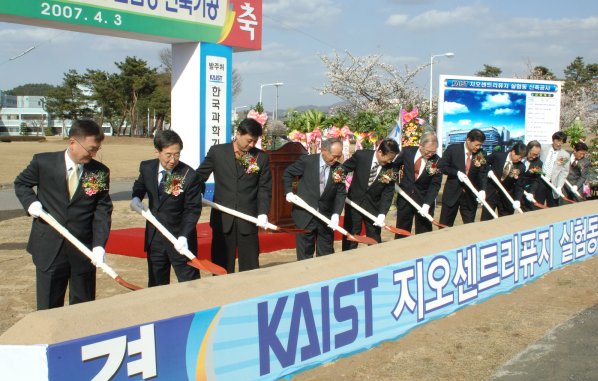event
- Geo-Centrifuge experiment center of an area of about 1,712 square meters and an estimated construction cost of total 8.4 billion won
- Simulation laboratory in the field of geotechnical engineering with state-of-the-art experiment equipment
- Ground-breaking ceremony held on April 3 at 4 pm
KAIST will construct ‘distributed shared-type Geo-Centrifuge experiment center’, a large-scale civil engineering laboratory that will study natural disasters such as earthquake, embankment collapse, etc. with ground structure miniatures.
A two-story building with a basement occupying an area of about 1,712 square meters will become a landmark laboratory in the field of geotechnical engineering that can be used for the education, research, and social infrastructure design by universities, institutes, and corporations via high-speed information and communication network. The estimated construction cost is 8.4 billion won.
The center will be composed of experiment building including geo-centrifuge laboratory, model-making room, workshop, geotechnical engineering laboratory, and specimen storehouse; and research building including control room, video conference room, electronic library, and research rooms. A variety of convenience facilities for researchers and video conference and remote monitoring system, with which researcher at remote distances can directly participate in experiments, will be provided in the research building, and world’s top-class experiment equipment such as geo-centrifuge with a turning radius of 5 meters, a maximum acceleration of 130 G (130 times faster than the acceleration of gravity), a preload of 2,400 kg and bidirectional shaking-table that can reproduce earthquakes-like wave during experiments, and robots that can reproduce construction procedures by a remote control will be installed.
Geo-Centrifuge experiment refers to an experiment that reproduces natural disaster-like motions by making miniatures of large-scale ground structures such as dams, slopes, etc. and using centrifugal forces generated from high-speed rotation. This experiment can easily and rapidly reproduce actual motions of ground structures at a low cost, thereby being widely used for various geotechnical engineering researches such as evaluation of seismic safety, movement of soft ground, slope stability analysis, etc. The causes of the embankment collapse in New Orleans by Hurricane Katrina in 2005 were also revealed by simulation tests by this experiment.
“The center will make possible a variety of experiments and researches that have never been available in Korea due to the lack of experiment infrastructure, therefore activate researches over the design and construction of large-scale social infrastructures. Making possible civil engineering researches demanding the use of large-scale equipment like Centrifuge, severely dependent on overseas technologies so far, will enhance the global competitiveness of Korean construction industry,” said Dong-soo Kim, President of the center.
The center will be constructed as part of the Ministry of Construction & Transportation (MOCT)’s project for the establishment of distributed shared-style construction research infrastructure, which is designed to establish construction research infrastructures in a national level. The ground breaking ceremony was held at KAIST on April 3 at 4 pm.

-
event KAIST School of Computing Unveils 'KRAFTON Building,' A Symbol of Collective Generosity
< (From the fifth from the left) Provost and Executive Vice President Gyun Min Lee, Auditor Eun Woo Lee, President Kwang-Hyung Lee, Dean of the School of Computing Seok-Young Ryu, former Krafton member and donor Woong-Hee Cho, Krafton Chairman Byung-Gyu Chang > KAIST announced on May 20th the completion of the expansion building for its School of Computing, the "KRAFTON Building." The project began in June 2021 with an ₩11 billion donation from KRAFTON and its employees, eventually gr
2025-05-21 -
event Life Springs at KAIST: A Tale of Two Special Campus Families
A Gift of Life on Teachers' Day: Baby Geese Born at KAIST Pond On Teachers' Day, a meaningful miracle of life arrived at the KAIST campus. A pair of geese gave birth to two goslings by the duck pond. < On Teachers' Day, a pair of geese and their goslings leisurely swim in the pond. > The baby goslings, covered in yellow down, began exploring the pond's edge, scurrying about, while their aunt geese steadfastly stood by. Their curious glances, watchful gazes, playful hops on water
2025-05-21 -
event KAIST Art Museum Showcases the Works of Van Gogh, Cy Twombly, and More at "The Vault of Masterpieces"
KAIST (President Kwang Hyung Lee) opened a special exhibition, "The Vault of Masterpieces", featuring the architects of the Gallerist Hong Gyu Shin, who is active in New York, on April 29th. Since its opening in December 2024, the KAIST Museum of Art, which has mainly exhibited works from its own collection, has boldly invited internationally renowned Gallerist Shin Hong-gyu to hold its first full-scale special exhibition, displaying a large number of his collections in the center of the camp
2025-04-30 -
event Formosa Group of Taiwan to Establish Bio R&D Center at KAIST Investing 12.5 M USD
KAIST (President Kwang-Hyung Lee) announced on February 17th that it signed an agreement for cooperation in the bio-medical field with Formosa Group, one of the three largest companies in Taiwan. < Formosa Group Chairman Sandy Wang and KAIST President Kwang-Hyung Lee at the signing ceremony > Formosa Group Executive Committee member and Chairman Sandy Wang, who leads the group's bio and eco-friendly energy sectors, decided to establish a bio-medical research center within KAIST and i
2025-02-17 -
research KAIST Develops Wearable Carbon Dioxide Sensor to Enable Real-time Apnea Diagnosis
- Professor Seunghyup Yoo’s research team of the School of Electrical Engineering developed an ultralow-power carbon dioxide (CO2) sensor using a flexible and thin organic photodiode, and succeeded in real-time breathing monitoring by attaching it to a commercial mask - Wearable devices with features such as low power, high stability, and flexibility can be utilized for early diagnosis of various diseases such as chronic obstructive pulmonary disease and sleep apnea < Photo 1. Fro
2025-02-13